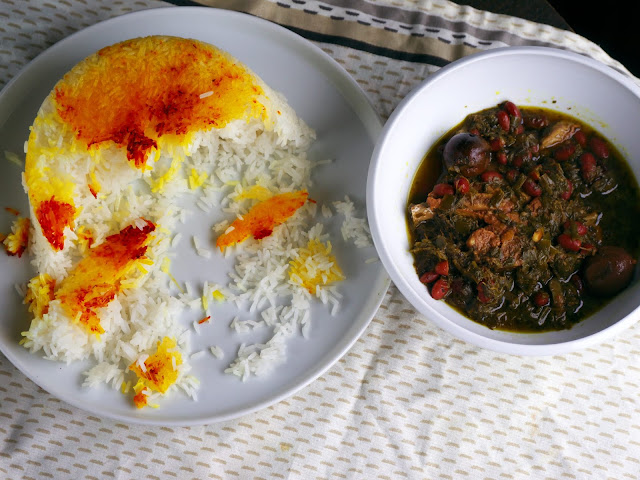"Ghorme-Sabzi" literally means "Herbal Stew" in Farsi (i.e. the Persian language). Although the stew does not have much to offer in the way of appearance, its magical taste makes it the most likely candidate for Iran's national dish (subject to dispute between that and kebab). The stew showcases some of the most unique features and ingredients of the Persian cuisine. The dominating flavor theme of the Persian cuisine is sour and salty, Ghorme-Sabzi well represents such feature; it also contains dried Persian limes, the most unique Persian ingredient. For the Persian folks, Ghorme-Sabzi represents more than just a dish. It is a full package of childhood memories, offered in form of a humble stew.
As John Irving once said:
“Your memory is a monster; you forget—it doesn't. It simply files things away. It keeps things for you, or hides things from you—and summons them to your recall with will of its own. You think you have a memory; but it has you!”
.... Ghorme-Sabzi exactly does that....
Ingredients:
1 Pound (~450 gr) beef ribs or bone-in lamb stewing meat (preferably
shoulder or neck)
Flour, salt and pepper for dredging
1 medium yellow onion, finely chopped
1/2 TSP turmeric
1/2 TSP coriander powder
Pinch of Saffron
3 cups brown beef stock (or water)
1 cup kidney beans (in some regions of Iran black eyed
peas are used)
Ghorme sabzi herb mixture(recipe follows)
3 dried Persian limes (see note)
Ghorme sabzi herb mixture:
200 gr (~7.05 Oz ) Chinese chives
300 gr (~10.58 Oz) Italian parsley
50 gr (~1.75 ) fenugreek leaves or 1 TBSP dried fenugreek*
*In some Iranian regions other herbs such as cilantro, spinach, Swiss
chard and even tarragon (North western Turkish region) are used. I personally
like the above simple mixture from the capital (Tehran)
Note:
Use 3 dried Persian limes to stick to the traditional
versions. These could be found in Persian or Middle eastern stores or more conveniently online!.
Other alternatives could be:
1 whole preserved lemon, or
1 cup of verjuice, or
1 cup sour
orange juice.
 |
Wash the herb by submerging them in plenty of warm water. Soil and
solid wastes will be settled and herbs will float atop. The washed herbs should be collected from
surface. Dry the herbs using a salad spinner. The herbs should be chopped next; to facilitate the chopping process, use a kitchen twine.Wrap the twine around a bunch and form a tightly packed bundle. Starting from one end, chop the herbs very finely with a sharp knife. You can alternatively use a food processor to finely chop the herbs to coarsely chop the herbs (the juices should not be released).
|
 |
Put the herb mixture in a pan, set over medium heat. Cook the herb mixture until the moisture in herbs is evaporated.
At this point, add enough oil to fry the herbs. Cook until the herbs are
dark green and start to smell nutty.
|
 |
Assuming that your
herb mixture is ready, we now can proceed to the next stage: cooking the stew!
Dredge the meat in seasoned flour and brown the meat in a hot skillet. Remove the meat from the and set a side.
|
 |
In the same pan, lightly brown the onions, add the spices and
then the herb mixture. Here I used sour orange juice as the sour agent (see the note in recipe). Add
the stock (or water as it is typically done). If you use dried limes, poke holes in each of them using a knife. Add them to the pot.
|
 |
The best way to cook Ghorme-Sabzi is low and slow! And what
would be better for that than the slow cooker?
|
 |
Add the browned meat, beans, and the herbal mixture to the slow cooker. Layer the surface with parchment and cook on low over-night.
This could be done on stove top over very low heat well. Do to so, decrease the heat, put the lid and cook
for two hours or till the meat is tender.
|
 |
This is what you are supposed to see the morning after! Skim the excess fat with a spoon.
|










Comments
بهمین خاطره که به گوشتی که به روش قدیمی(سنتی!) کنسرو شده, قورمه میگفتن؛ چون برای اینکار از تکه های بزرگ گوشت استفاده میکردن.